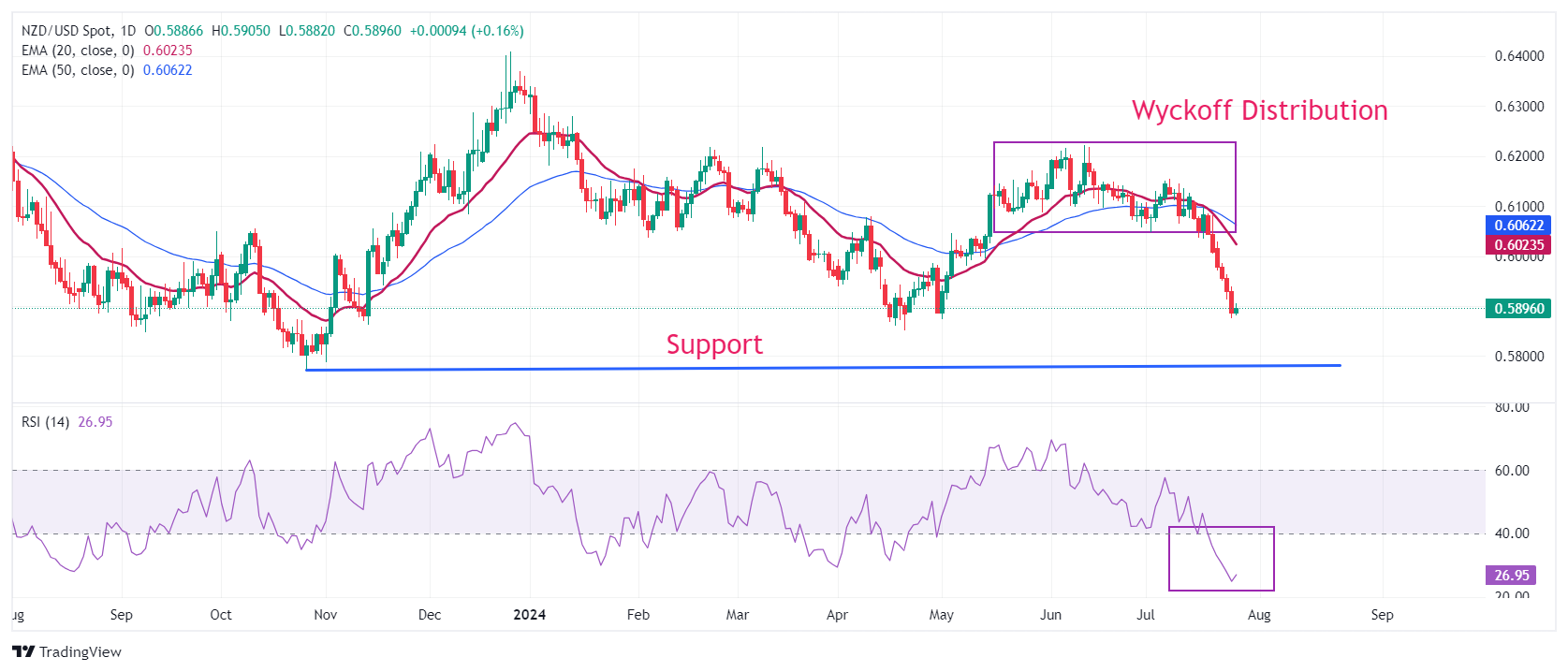NZD/USD Price Analysis: Strives to come out of woods
|
- NZD/USD finds a cushion near 0.5880, while the overall outlook remains bearish.
- Investors await the US core PCE inflation for June for fresh guidance on Fed interest rates.
- The New Zealand Dollar weakens due to multiple headwinds.
The NZD/USD pair finds temporary support near an almost three-month low of 0.5880 in Friday’s European session after a six-day losing spell. The Kiwi asset gains an ad-hoc ground as the US Dollar (USD) edges lower ahead of the United States (US) core Personal Consumption Expenditure price index (PCE) data for June, which will be published at 12:30 GMT.
The underlying inflation will influence market expectations for Federal Reserve (Fed) rate cuts this year. According to the CME FedWatch tool, traders remain confident that the central bank will start reducing interest rates from the September meeting.
Economists expect that the annual core PCE Price Index grew at a slower pace of 2.5% from May’s reading of 2.6%, with monthly inflation rising steadily by 0.1%.
Meanwhile, the New Zealand Dollar (NZD) has faced significant selling pressure this week due to China’s dismal economic prospects and rising expectations of rate cuts by the Reserve Bank of New Zealand (RBNZ) this year.
NZD/USD weakened after a breakdown of the Wyckoff Distribution formation on a daily timeframe. The Wyckoff Distribution exhibits the transfer of inventory from institutional investors to retail participants. The asset may find support near the trendline around 0.5900, plotted from 26 October 2023 low at 0.5770.
A bear cross, represented by 20- and 50-day Exponential Moving Averages (EMAs) near 0.6090 suggests that the overall trend is bearish.
The 14-day Relative Strength Index (RSI) shifts into the bearish range of 20.00-40.00, suggesting that a bearish momentum is intact.
More downside would appear if the asset breaks below April 19 low around 0.5850. This would drag the asset towards the round-level support of 0.5800, followed by 26 October 2023 low at 0.5770.
In an alternate scenario, a recovery move above the psychological resistance of 0.6000 would shift the trend towards the upside. This would push the asset higher to May 3 high at 0.6046 and July 17 high near 0.6100.
NZD/USD daily chart
New Zealand Dollar FAQs
The New Zealand Dollar (NZD), also known as the Kiwi, is a well-known traded currency among investors. Its value is broadly determined by the health of the New Zealand economy and the country’s central bank policy. Still, there are some unique particularities that also can make NZD move. The performance of the Chinese economy tends to move the Kiwi because China is New Zealand’s biggest trading partner. Bad news for the Chinese economy likely means less New Zealand exports to the country, hitting the economy and thus its currency. Another factor moving NZD is dairy prices as the dairy industry is New Zealand’s main export. High dairy prices boost export income, contributing positively to the economy and thus to the NZD.
The Reserve Bank of New Zealand (RBNZ) aims to achieve and maintain an inflation rate between 1% and 3% over the medium term, with a focus to keep it near the 2% mid-point. To this end, the bank sets an appropriate level of interest rates. When inflation is too high, the RBNZ will increase interest rates to cool the economy, but the move will also make bond yields higher, increasing investors’ appeal to invest in the country and thus boosting NZD. On the contrary, lower interest rates tend to weaken NZD. The so-called rate differential, or how rates in New Zealand are or are expected to be compared to the ones set by the US Federal Reserve, can also play a key role in moving the NZD/USD pair.
Macroeconomic data releases in New Zealand are key to assess the state of the economy and can impact the New Zealand Dollar’s (NZD) valuation. A strong economy, based on high economic growth, low unemployment and high confidence is good for NZD. High economic growth attracts foreign investment and may encourage the Reserve Bank of New Zealand to increase interest rates, if this economic strength comes together with elevated inflation. Conversely, if economic data is weak, NZD is likely to depreciate.
The New Zealand Dollar (NZD) tends to strengthen during risk-on periods, or when investors perceive that broader market risks are low and are optimistic about growth. This tends to lead to a more favorable outlook for commodities and so-called ‘commodity currencies’ such as the Kiwi. Conversely, NZD tends to weaken at times of market turbulence or economic uncertainty as investors tend to sell higher-risk assets and flee to the more-stable safe havens.
Information on these pages contains forward-looking statements that involve risks and uncertainties. Markets and instruments profiled on this page are for informational purposes only and should not in any way come across as a recommendation to buy or sell in these assets. You should do your own thorough research before making any investment decisions. FXStreet does not in any way guarantee that this information is free from mistakes, errors, or material misstatements. It also does not guarantee that this information is of a timely nature. Investing in Open Markets involves a great deal of risk, including the loss of all or a portion of your investment, as well as emotional distress. All risks, losses and costs associated with investing, including total loss of principal, are your responsibility. The views and opinions expressed in this article are those of the authors and do not necessarily reflect the official policy or position of FXStreet nor its advertisers.
